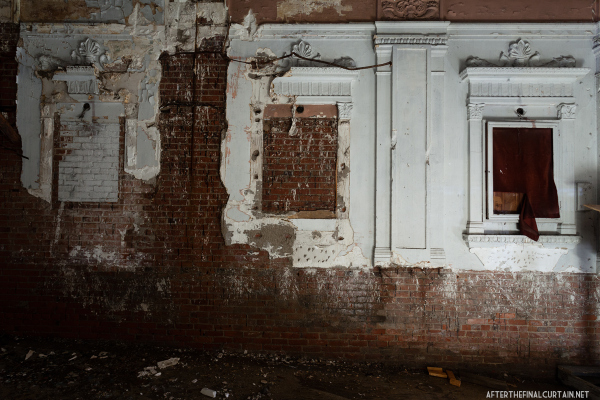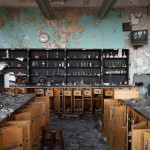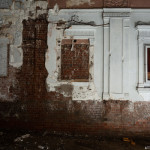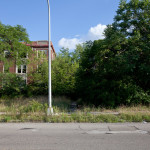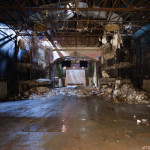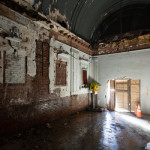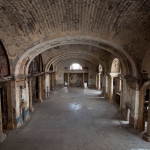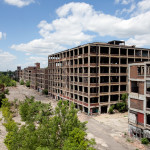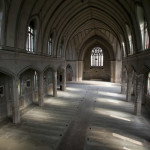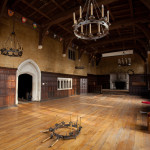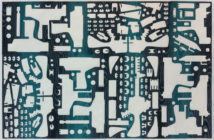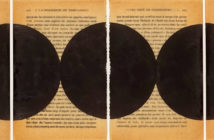Images of decay have a long history. Most notable is their popularity with romantic painters of the early nineteenth century, who utilized images of decline to evoke emotive reactions to societal change. For British artists, paintings of long abandoned, forlorn abbeys served dually as both comments on contemporary societal change as well as depictions of complicated histories. Impressive ruminations on the transition of time, these romantic broodings on decay were tied to a rapidly changing socio-economic status quo. As nations like Britain made the shift to industrialization, artists pondered what the rapid progress would mean and how it would affect the world. One of the sweethearts of this movement in the America’s Hudson River School was Thomas Cole.
One set of images Cole created, now in the collection of the Mead Art Museum at Amherst College, gives the viewer an early prototype for the before and after shots so popular now among photographers of decay. The pair, appropriately titled The Past and The Present, shows an imagined castle both in its prime as a site dedicated to courtly romances and in a state of utter devastation. Colorful garments and shining knights give way to a stark landscape where time has taken its toll. The comparison is direct and striking. Viewers simultaneously experience past and present, seeing what was and what is.
Of course the pair of images gushes with sentimentality as romantic works are wont to do, but they also convey a basic truth about time: It moves on, and eventually leaves everything behind. Cole captures in two paintings the appeal of ruin imagery. It gives the viewer a chance to yearn for times past while also serving as a practical tool to discuss history. Ruin images are meditations on the end, on the finite nature of all things. They are also roadmaps for history experienced; leaving the viewer separated from them by space and time, and yearning for their stories and places.
Today, decline is popular among professional and amateur photographers alike. The phenomenon of ruin photography has been expanded and democratized by the wide availability not only of photographic tools, but of internet publishing platforms where explorer-artists can share the images they created on visits to decaying sites that are often cut off from the world. The accessibility and ease of use of blogging tools like WordPress have made it easier than ever to bring these images to market. New technologies have liberated ruin imagery from the canvas, and even from the framed photographic print, bringing stories of decay to a wider public. The work retains the trappings of art while taking on new and powerful qualities as well. Photos of ruins become viral and virtual landmarks around which conversation about blight and historic preservation can take place.
ArtInRuins.com, a Rhode Island based blog, aggregates images of sites in various states of use, disuse, and restoration. It activates the images with chat boards, enabling viewers to contribute their own stories about the landmarks it seeks to save. Part historic preservation tool, part gallery, and part symposium, the site is a powerful asset that brings advocates for historic places together while celebrating the aesthetic of sites in decline.
Sites like ArtInRuins.com are enormously popular, and nearly every major city has such an online community of decay enthusiasts that double as preservationists. Perhaps the most famous, and most over-photographed, of these metropolises is Detroit, Michigan. The once great city is frequently pictured as abandoned and collapsing by roving explorer-photographers. The images of this iconic American city have even developed their own unique problems. Photos of abandoned and disused Detroit landmarks are so ubiquitous that some have claimed they are actually hindering the economic rebound of a city trying to reclaim its spot as a national leader.
But the sites dedicated to such imagery provide important resources that empower historians and urbanists at the local level. One blog dedicated to capturing the Motor City, Detroiturbex.com, is a feast of rich imagery paired with encyclopedic amounts of information. The blog covers every imaginable site in the city, breaking them down into categories ranging from industrial spaces to residential to religious. The images document the huge number of buildings that have seen vandalism and lack of use due to a collapse in the population and economy of one of America’s greatest cities. In addition to photos of landmarks in various states of destruction, the site offers rich histories, pairing images of abandoned places with stories of their respective lives in the heyday of the city. In this way, the site becomes an important place for discussion and memory. It acts as a centerpiece of oral tradition and encourages viewers and residents to take pride in these places.
A myriad of niche subset blogs have also cropped up. One of these is AfterTheFinalCurtain.net, a blog dedicated to photography of abandoned and disused theatres. Matt Lambos, the site’s owner, documents vacated movie houses around the country, with a clear and deep appreciation for the architectural grandeur which once defined theatres as palaces for average people. One of the sites he visited and documented was the former Liberty Theatre in Dorchester Massachusetts.
Now demolished, the Liberty Theatre opened in 1922 and closed as a theatre in the 1950s. Lambros’s photos of the site are strangely moving because it is barely recognizable as a theatre of any kind. Though most of the interior was stripped out before the photographer had an opportunity to document the theatre, some elements remain, like the proscenium arch, perhaps the architectural detail most indicative of its former use. Parts of the rich plasterwork lobby can also be seen, making viewers long to see what it once looked like.
The photos of the Liberty are as much a dialogue about changing cities and ways of life as they are about a decline in architecture. The theatre, that at one period in Dorchester’s history saw a great deal of use, was closed to the public for almost half a century before being demolished. The attraction to a place like the Liberty, a theatre tucked on a main street rather than hidden in a suburban multiplex, is as much about authenticity as about convenience. A younger generation craves the originality of places like the Liberty, which in contemporary life are seen as unique bulwarks against the corporatism of chain cinemas.
The images provided on these sites offer a broad perspective of the state of urban neighborhoods in the wake of a rapidly changing United States. They depict the shift away from one kind of life and toward another. Where the factories disappeared in Detroit, so too did the once vibrant neighborhoods, and schools, and churches, that supported them. The quaint movie houses of the early twentieth century gave way to sprawling theatres set amidst the sprawl of suburbia.
The Tate's Ruin Lust brings the conversation about ruins back to the museum setting. It brings the power of ruin imagery back to the place it started on all those romantic canvases of crumbling castles and abbeys. Ruin Lust is not the close of a circle, but the circling back of a discussion about the nature of place. In light of the history of ruins, contemporary ruin photography, and the blogs associated with it, could hardly be more inseparable in spirit from Thomas Cole’s dainty paintings at the Mead. The romantic notions so wrapped up in both forms, and expressed by their divergent styles, are more potent today than ever. The widespread possibility for the creation of ruin photography has initiated an important conversation with romantic predecessors. Both kinds of images, romantic paintings and contemporary photographs, tap into something primordial, into yearning and memory. Most importantly though, photographs of places near death give viewers a better grasp on a rapidly changing world, as romantic paintings did two centuries before.
- Cass Technical High School, Detroit.
- Dorchester’s Liberty Theatre
- Balfour Manor Apartments, Detroit.
- Dorchester’s Liberty Theatre
- Dorchester’s Liberty Theatre
- Michigan Central Station, Detroit.
- Packard Automobile Plant, Detroit.
- St. Agnes Martyrs of Uganda Parish Church, Detroit.
- The University Club, Detroit.

